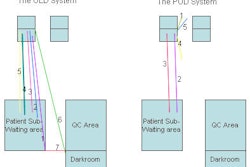Women with an average risk for breast cancer may be overly concerned about the disease, while those with a higher risk may be too nonchalant about it, according to a survey of more than 1,000 U.S. women.
Dr. Jennifer Haas and colleagues initiated this study because they were "interested in examining not only sociodemographic and clinical risk factors but also the influence on the lay media on a woman's perception of her breast cancer risk" (Journal of Women's Health, November 2005, Vol. 14:9, pp. 845-851).
Haas is from Brigham and Women's Hospital in Boston. Her co-authors, including Dr. Karla Kerlikowske, are from the University of California, San Francisco.
Potential participants in this survey were compiled from the San Francisco Mammography Registry (SFMR). Women, ages 40-74 years, who had undergone screening mammography at one of five SFMR facilities were eligible. They were asked to identify themselves as Asian-Pacific Islander, black, Latina, or white.
From this list, 2,800 names were randomly selected by ethnicity and the level of five-year breast cancer risk. Other independent characteristics included the frequency of exposure to breast health information through the media. The women's responses were categorized as either higher than average or lower than average.
Of the 2,800 women who were surveyed, 1,711 completed the study for a response rate of 63%. Minorities responded at a lower rate than white women (77% response rate). The final analysis was done on 1,619 women.
According to those results, 72% of women at average risk for breast cancer accurately perceived their status. But among women at higher risk, only 43.1% accurately perceived their status.
Women at average risk, yet harboring a greater concern about breast cancer, tended to be younger, have a family history, and be white. Also, women who reported frequent media exposure were more likely to believe in an increased risk. Interestingly, "prior breast biopsy and prior history of an abnormal mammogram were not associated with the perception of risk," Haas' group stated.
For women at increased risk, those who were younger and those with a family history of breast cancer were more likely to accurately perceive their risk status. Not surprisingly, black women at high risk were less likely to consider their breast cancer status. Historically, women of color have had lower screening compliance rates.
Finally, the group found that frequent media exposure to breast health issues was associated with an overestimation of risk. However, this association did not necessarily mean that these women were religiously sticking with their annual screening schedule.
By Shalmali Pal
AuntMinnie.com staff writer
January 19, 2006
Related Reading
Sidestepping screening: What factors make women avoid annual mammography? October 10, 2005
Many women fail to get regular mammograms, September 14, 2005
When push comes to shove: Addressing compression in mammography, October 5, 2004
Malpractice and mammography: An exam oversold? July 15, 2004
Bollywood-style song inspires U.K. women to get mammograms, February 10, 2004
Copyright © 2006 AuntMinnie.com



















